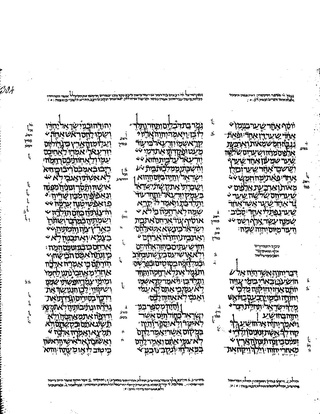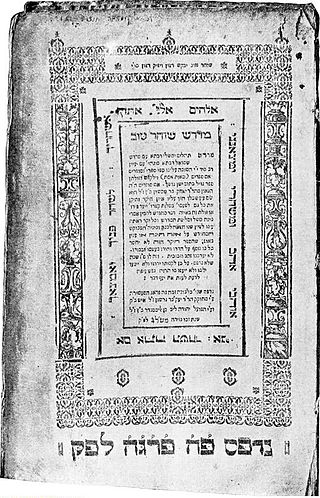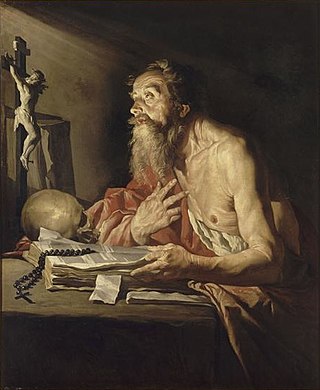
The Book of Zephaniah is the ninth of the Twelve Minor Prophets of the Old Testament and Tanakh, preceded by the Book of Habakkuk and followed by the Book of Haggai. Zephaniah means "Yahweh has hidden/protected," or "Yahweh hides". Zephaniah is also a male given name. The original text was written in Biblical Hebrew.

The Epistle to the Hebrews is one of the books of the New Testament.

Jacob Neusner was an American academic scholar of Judaism. He was named as one of the most published authors in history, having written or edited more than 900 books.

Midrash is expansive Jewish Biblical exegesis using a rabbinic mode of interpretation prominent in the Talmud. The word itself means "textual interpretation", "study", or "exegesis", derived from the root verb darash (דָּרַשׁ), which means "resort to, seek, seek with care, enquire, require", forms of which appear frequently in the Hebrew Bible.

The Jewish Theological Seminary (JTS) is a Conservative Jewish education organization in New York City, New York. It is one of the academic and spiritual centers of Conservative Judaism and a center for academic scholarship in Jewish studies. The Jewish Theological Seminary Library is one of the most significant collections of Judaica in the world.
Burton L. Mack was an American author and scholar of early Christian history and the New Testament. He was John Wesley Professor emeritus in early Christianity at the Claremont School of Theology in Claremont, California. Mack was primarily a scholar of Christian origins, approaching it from the angle of social group formation. Mack's approach was skeptical, and he saw traditional Christian documents like the Gospels as myth as opposed to history. He viewed the gospels more as charter documents of the early Christian movements, not as reliable accounts of the life of Jesus.
The Ketuvim is the third and final section of the Tanakh, after Torah ("instruction") and Nevi'im ("prophets"). In English translations of the Hebrew Bible, this section is usually titled "Writings" or "Hagiographa".
The Anchor Bible Series, which consists of a commentary series, a Bible dictionary, and a reference library, is a scholarly and commercial co-venture which was begun in 1956, with the publication of individual volumes in the commentary series. Over 1,000 scholars—representing Jewish, Catholic, Eastern Orthodox, Protestant, Muslim, secular, and other traditions—have contributed to the project. Their works offer discussions that reflect a range of viewpoints across a wide theological spectrum.

Joseph Augustine Fitzmyer was an American Catholic priest and scholar who taught at several American and British universities. He was a member of the Society of Jesus (Jesuits).
The biblical term "proselyte" is an anglicization of the Koine Greek term προσήλυτος (proselytos), as used in the Septuagint for "stranger", i.e. a "newcomer to Israel"; a "sojourner in the land", and in the Greek New Testament for a first-century convert to Judaism, generally from Ancient Greek religion. It is a translation of the Biblical Hebrew phrase גר תושב. "Proselyte" also has the more general meaning in English of a new convert to any particular religion or doctrine.
The Society of Biblical Literature (SBL), founded in 1880 as the Society of Biblical Literature and Exegesis, is an American-based learned society dedicated to the academic study of the Bible and related ancient literature. Its current stated mission is to "foster biblical scholarship". Membership is open to the public and consists of over 8,300 individuals from over 100 countries. As a scholarly organization, SBL has been a constituent society of the American Council of Learned Societies since 1929.
Harold William Attridge is an American New Testament scholar and historian of Christianity known for his work in New Testament exegesis, especially the Epistle to the Hebrews, the study of Hellenistic Judaism, and the history of early Christianity. He is a Sterling Professor of Divinity at Yale University, where he served as Dean of the Divinity School from 2002 to 2012, the first Roman Catholic to head that historically Protestant school.

Christian M. M. Brady is an American scholar who specializes in biblical literature, rabbinic literature, and the targumim, especially Targum Lamentations and Targum Ruth. He is the inaugural Dean of the Lewis Honors College and Professor of Modern and Classical Languages, Literatures, and Cultures at the University of Kentucky (2017). He was interim dean of the College of Arts & Sciences at the University of Kentucky from 2020 to 2022. He was Dean of the Schreyer Honors College from 2006 to 2016. He was formerly associate professor of Classical Studies and Jewish Studies at Tulane University. His administrative roles at Tulane included, associate director of the Jewish Studies Program (1997-1998), Director of the Jewish Studies Program (1998-2003), associate director of the Honors Program (2003-2004), and Director of the Honors Program (2004–2006).
Michael A. Fishbane is an American scholar of Judaism and rabbinic literature. Formerly at Brandeis University, he is currently Professor Emeritus of Jewish Studies at the Divinity School, University of Chicago.
Jon Douglas Levenson is an American Hebrew Bible scholar who is the Albert A. List Professor of Jewish Studies at the Harvard Divinity School.

The origins of Judaism lie in Bronze Age polytheistic Canaanite religion. Judaism also syncretized elements of other Semitic religions such as Babylonian religion, which is reflected in the early prophetic books of the Hebrew Bible.
John J. Collins is an Irish-born American biblical scholar, the Holmes Professor of Old Testament Criticism and Interpretation at Yale Divinity School. He is noted for his research in the Hebrew Bible, as well as the apocryphal works of the Second Temple period including the sectarian works found in Dead Sea Scrolls and their relation to Christian origins. Collins has published and edited over 300 scholarly works, and a number of popular level articles and books. Among his best known works are the Between Athens and Jerusalem: Jewish Identity in the Hellenistic Diaspora ; Daniel in the Hermeneia commentary series ; The Scepter and the Star. The Messiahs of the Dead Sea Scrolls and Other Ancient Literature ; and The Bible after Babel: Historical Criticism in a Postmodern Age.
Kabbalah, the central system in Jewish mysticism, uses anthropomorphic mythic symbols to metaphorically describe manifestations of God in Judaism. Based on the verses "God created man in his own image, in the image of God created he him; male and female created he them" and "from my flesh shall I see God", Kabbalah uses the form of the human body to describe the structure of the human soul, and the nature of supernal Divine emanations. A particular concern of Kabbalah is sexual unity between male and female potencies in Divinity on high, depicted as interaction of the two sides in the sephirot, between archetypal partzufim, and the redemption of the exiled Shekhinah from captivity among the impure forces below.

The Jerome Biblical Commentary is a series of books of Biblical scholarship, whose first edition was published in 1968. It is arguably the most-used volume of Catholic scriptural commentary in the United States.
Julian Morgenstern was an American rabbi, Bible scholar, and president of Hebrew Union College.










